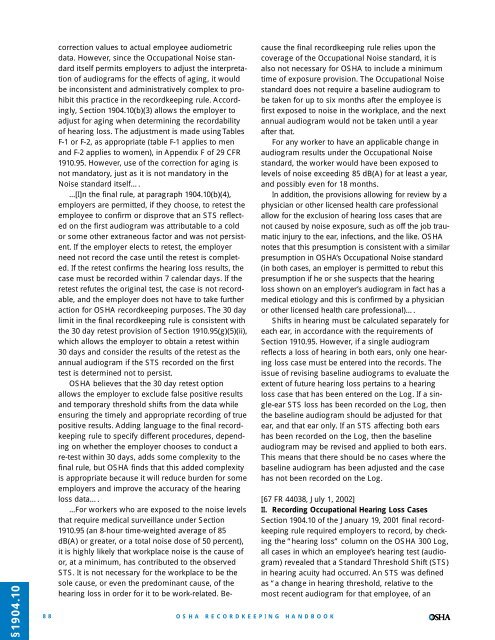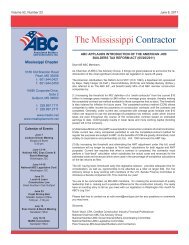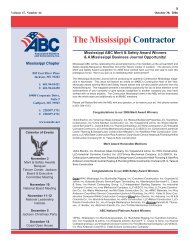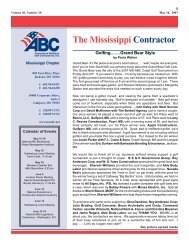§1904.1088<strong>OSHA</strong> RECORDKEEPINGcorrection values to actual employee audiometricdata. However, since the Occupational Noise standarditself permits employers to adjust the interpretationof audiograms for the effects of aging, it wouldbe inconsistent and administratively complex to prohibitthis practice in the recordkeeping rule. Accordingly,Section 1904.10(b)(3) allows the employer toadjust for aging when determining the recordabilityof hearing loss. The adjustment is made using TablesF-1 or F-2, as appropriate (table F-1 applies to menand F-2 applies to women), in Appendix F of 29 CFR1910.95. However, use of the correction for aging isnot mandatory, just as it is not mandatory in theNoise standard itself…....[I]n the final rule, at paragraph 1904.10(b)(4),employers are permitted, if they choose, to retest theemployee to confirm or disprove that an STS reflectedon the first audiogram was attributable to a coldor some other extraneous factor and was not persistent.If the employer elects to retest, the employerneed not record the case until the retest is completed.If the retest confirms the hearing loss results, thecase must be recorded within 7 calendar days. If theretest refutes the original test, the case is not recordable,and the employer does not have to take furtheraction for <strong>OSHA</strong> recordkeeping purposes. The 30 daylimit in the final recordkeeping rule is consistent withthe 30 day retest provision of Section 1910.95(g)(5)(ii),which allows the employer to obtain a retest within30 days and consider the results of the retest as theannual audiogram if the STS recorded on the firsttest is determined not to persist.<strong>OSHA</strong> believes that the 30 day retest optionallows the employer to exclude false positive resultsand temporary threshold shifts from the data whileensuring the timely and appropriate recording of truepositive results. Adding language to the final recordkeepingrule to specify different procedures, dependingon whether the employer chooses to conduct are-test within 30 days, adds some complexity to thefinal rule, but <strong>OSHA</strong> finds that this added complexityis appropriate because it will reduce burden for someemployers and improve the accuracy of the hearingloss data…....For workers who are exposed to the noise levelsthat require medical surveillance under Section1910.95 (an 8-hour time-weighted average of 85dB(A) or greater, or a total noise dose of 50 percent),it is highly likely that workplace noise is the cause ofor, at a minimum, has contributed to the observedSTS. It is not necessary for the workplace to be thesole cause, or even the predominant cause, of thehearing loss in order for it to be work-related. Becausethe final recordkeeping rule relies upon thecoverage of the Occupational Noise standard, it isalso not necessary for <strong>OSHA</strong> to include a minimumtime of exposure provision. The Occupational Noisestandard does not require a baseline audiogram tobe taken for up to six months after the employee isfirst exposed to noise in the workplace, and the nextannual audiogram would not be taken until a yearafter that.For any worker to have an applicable change inaudiogram results under the Occupational Noisestandard, the worker would have been exposed tolevels of noise exceeding 85 dB(A) for at least a year,and possibly even for 18 months.In addition, the provisions allowing for review by aphysician or other licensed health care professionalallow for the exclusion of hearing loss cases that arenot caused by noise exposure, such as off the job traumaticinjury to the ear, infections, and the like. <strong>OSHA</strong>notes that this presumption is consistent with a similarpresumption in <strong>OSHA</strong>’s Occupational Noise standard(in both cases, an employer is permitted to rebut thispresumption if he or she suspects that the hearingloss shown on an employer’s audiogram in fact has amedical etiology and this is confirmed by a physicianor other licensed health care professional)….Shifts in hearing must be calculated separately foreach ear, in accordance with the requirements ofSection 1910.95. However, if a single audiogramreflects a loss of hearing in both ears, only one hearingloss case must be entered into the records. Theissue of revising baseline audiograms to evaluate theextent of future hearing loss pertains to a hearingloss case that has been entered on the Log. If a single-earSTS loss has been recorded on the Log, thenthe baseline audiogram should be adjusted for thatear, and that ear only. If an STS affecting both earshas been recorded on the Log, then the baselineaudiogram may be revised and applied to both ears.This means that there should be no cases where thebaseline audiogram has been adjusted and the casehas not been recorded on the Log.[67 FR 44038, July 1, 2002]II. Recording Occupational Hearing Loss CasesSection 1904.10 of the January 19, 2001 final recordkeepingrule required employers to record, by checkingthe “hearing loss” column on the <strong>OSHA</strong> 300 Log,all cases in which an employee’s hearing test (audiogram)revealed that a Standard Threshold Shift (STS)in hearing acuity had occurred. An STS was definedas “a change in hearing threshold, relative to themost recent audiogram for that employee, of anHANDBOOK
average of 10 decibels or more at 2000, 3000 and4000 Hertz (Hz) in one or both ears.” The recordkeepingrule itself does not require the employer to testemployee’s hearing. However, <strong>OSHA</strong>’s occupationalnoise standard (29 CFR 1910.95) requires employersin general industry to conduct periodic audiometrictesting of employees when employees’ noise exposuresare equal to, or exceed, an 8-hour time-weightedaverage of 85dBA. Under the provisions ofSection 1910.95, if such testing reveals that anemployee has sustained a hearing loss equal to anSTS, the employer must take protective measures,including requiring the use of hearing protectors, toprevent further hearing loss. Employers in the construction,agriculture, oil and gas drilling and servicing,and shipbuilding industries are not covered bySection 1910.95, and therefore are not required by<strong>OSHA</strong> to provide hearing tests. If employers in theseindustries voluntarily conduct hearing tests they arerequired to record hearing loss cases meeting therecording criteria set forth in the final Section 1904.10rule.[67 FR 77169, Dec.17, 2002]D. Other Hearing Loss Issues<strong>OSHA</strong> would like to clarify three matters in relation torecording occupational hearing loss in conjunctionwith the Section 1904.10 final rule issued July 1,2002. First, the preamble to the final rule stated thatemployers in the shipbuilding industries are not coveredby <strong>OSHA</strong>’s noise standard Section 1910.95 andare therefore not required to perform audiometrictests. (67 FR 44038, 44040). This statement was anerror. <strong>OSHA</strong> Directive STD 0.2 Identification ofGeneral Industry Safety and Health Standards (29CFR 1910) Applicable to Shipyard Work specificallystates that employers in the shipbuilding industrythat are covered by the 29 CFR part 1915 Standardsare required to comply with a number of 29 CFR Part1910 standards, including the Section 1910.95 requirementsfor occupational noise.[67 FR 44038-44044, July 1, 2002]II. Recording Occupational Hearing Loss Cases(continued)One of the major issues in the recordkeeping rulemakingwas to determine the level of occupationalhearing loss that constitutes a health condition seri -ous enough to warrant recording. This was necessarybecause the final rule no longer requires recording ofminor or insignificant health conditions that do notresult in one or more of the general recording criteriasuch as medical treatment, restricted work, or days<strong>OSHA</strong> RECORDKEEPINGaway from work (See, e.g., 66 FR 5931). In its 1996Federal Register notice <strong>OSHA</strong> proposed a requirementto record hearing loss averaging 15 dB at 2000,3000 and 4000 Hz in one or both ears (61 FR 4040).<strong>OSHA</strong> adopted the lower 10-dB threshold in the finalrule based in part upon comments that “(a)n age-correctedSTS is a large hearing change that can affectcommunicative competence” (66 FR 6008).<strong>OSHA</strong>’s DecisionFollowing consideration of the comments received inresponse to the July 3, 2001 proposal to modify thehearing loss recording criteria, <strong>OSHA</strong> has decided torequire employers to record audiometric results indicatinga Standard Threshold Shift (STS) only whensuch STS cases also reflect a total hearing level of atleast 25 dB from audiometric zero. The STS calculationuses audiometric results averaged over the frequencies2000, 3000 and 4000 Hz, using the originalbaseline and annual audiograms required by the<strong>OSHA</strong> noise standard Section 1910.95. The rule alsoallows the employer to adjust the employee’s audiogramresults used to determine an STS to subtracthearing loss caused by aging, allows the employer toretest the workers’ hearing to make sure the hearingloss is persistent, and allows the employer to seekand follow the advice of a physician or licensedhealth care professional in determining whether ornot the hearing loss was work-related.The approach adopted in the final rule has severaladvantages. By using the STS definition from the<strong>OSHA</strong> noise standard Section 1910.95, the Section1904.10 regulation uses a sensitive measure of hearingloss that has occurred while the employee isemployed by his or her current employer. By requiringall STSs to exceed 25 dB from audiometric zero,the regulation assures that all recorded hearing lossesare significant illnesses. <strong>OSHA</strong> received no commentssuggesting that a shift of 25 dB from audiometriczero was anything less than a serious hearingloss case. While there is little consensus among thecommenters concerning the appropriate level thatshould be used to record hearing loss cases, there iswidespread agreement that a 25-dB shift from audiometriczero is a serious hearing loss.The hearing loss recording level is also compatiblewith the final rule’s definition of injury or illness,“an abnormal condition or disorder” (Section1904.46). Various scales used to rate hearing lossconsider hearing levels less than 25 dB to be withinthe “normal range” (American Medical AssociationGuidelines to the evaluation of Material Impairment,American Academy of Family Physicians, AudiologyHANDBOOK89§1904.10
- Page 1 and 2:
www.osha.govOSHARecordkeepingHandbo
- Page 3 and 4:
OSHARecordkeeping HandbookThe Regul
- Page 5 and 6:
ContentsRecordkeeping HandbookRoadm
- Page 7 and 8:
Section 1904.40Providing records to
- Page 9 and 10:
Section 1904.0Purpose(66 FR 6122, J
- Page 11 and 12:
Section 1904.1Partial exemption for
- Page 13 and 14:
Section 1904.2Partial exemption for
- Page 15 and 16:
employees, to OSHA within 8 hours (
- Page 17 and 18:
Partial Exemptions for Employers Un
- Page 19 and 20:
Section 1904.4Recording criteria(66
- Page 21 and 22:
Section 1904.5Determination of work
- Page 23 and 24:
(b)(7) How do I decide if a case is
- Page 25 and 26:
well, including providing informati
- Page 27 and 28:
This exception, which responds to i
- Page 29 and 30:
or she is in the work environment a
- Page 31 and 32:
have occurred but for the occupatio
- Page 33 and 34:
considered work-related. If an empl
- Page 35 and 36:
Question 5-12. Is work-related stre
- Page 37 and 38:
• The doctor described the illnes
- Page 39 and 40:
Scenario 7:• A site hired numerou
- Page 41 and 42:
Letter of interpretation related to
- Page 43 and 44:
These principles should be applied
- Page 45 and 46: The problem with the response is tw
- Page 47 and 48: Section 1904.6Determination of new
- Page 49 and 50: the Guidelines stated that “the a
- Page 51 and 52: estricted work. If the case is a pr
- Page 53 and 54: • The doctor also prescribed the
- Page 55 and 56: • The employees were under the di
- Page 57 and 58: Section 1904.7General recording cri
- Page 59 and 60: (iii) Do I have to record restricte
- Page 61 and 62: of the length of time the employee
- Page 63 and 64: then result in days away from work
- Page 65 and 66: A partial day of work is recorded a
- Page 67 and 68: In all other respects, the final ru
- Page 69 and 70: ments. The Agency believes that the
- Page 71 and 72: e recorded because it will require
- Page 73 and 74: However, episodes of fainting from
- Page 75 and 76: care professional, he or she may al
- Page 77 and 78: “Other simple means” of removin
- Page 79 and 80: For purposes of OSHA recordkeeping
- Page 81 and 82: • When answering the doctor’s q
- Page 83 and 84: Response: In the recordkeeping regu
- Page 85 and 86: Letter of interpretation related to
- Page 87 and 88: Section 1904.8Recording criteria fo
- Page 89 and 90: caused by contaminated needles and
- Page 91 and 92: Section 1904.9Recording criteria fo
- Page 93 and 94: Section 1904.10Recording criteria f
- Page 95: hearing loss case that is not relat
- Page 99 and 100: argued that because the function of
- Page 101 and 102: occurs, and where hearing loss can
- Page 103 and 104: cases in their workplace via analys
- Page 105 and 106: March 4, 2004Mr. Carl O. Sall, CIHD
- Page 107 and 108: When the professional evaluating th
- Page 109 and 110: (2) May I line-out or erase a recor
- Page 111 and 112: Section 1904.12Recording criteria f
- Page 113 and 114: These new statistics would add only
- Page 115 and 116: Sections 1904.13 - 1904.28 Reserved
- Page 117 and 118: two lines of the OSHA 300 Log to de
- Page 119 and 120: which replace the OSHA 200 and 101
- Page 121 and 122: different types of occupational ill
- Page 123 and 124: OSHA 301 form. These data are usefu
- Page 125 and 126: LETTERS OF INTERPRETATION: Section
- Page 127 and 128: Question 2: Under 29 CFR Section 19
- Page 129 and 130: and has adopted language in the fin
- Page 131 and 132: Section 1904.31Covered employees(66
- Page 133 and 134: label assigned to a worker is immat
- Page 135 and 136: These workers should be evaluated j
- Page 137 and 138: Response: A case is work-related if
- Page 139 and 140: Response: Section 1904.31 states th
- Page 141 and 142: Thank you for your interest in occu
- Page 143 and 144: year covered by the summary. The su
- Page 145 and 146: 2. Number of employees and hours wo
- Page 147 and 148:
LETTERS OF INTERPRETATION: Section
- Page 149 and 150:
Section 1904.33Retention and updati
- Page 151 and 152:
June 23, 2003Mr. Edwin G. Foulke, J
- Page 153 and 154:
Section 1904.34Change in business o
- Page 155 and 156:
PREAMBLE DISCUSSION: Section 1904.3
- Page 157 and 158:
Incident Report (Forms 300 and 301,
- Page 159 and 160:
workers’ compensation claim. See
- Page 161 and 162:
LETTERS OF INTERPRETATION: Section
- Page 163 and 164:
Letter of interpretation related to
- Page 165 and 166:
Question 3: Using the facts in Ques
- Page 167 and 168:
Section 1904.37State recordkeeping
- Page 169 and 170:
tion, require employers to report f
- Page 171 and 172:
(5) If I receive a variance, may th
- Page 173 and 174:
Section 1904.39Reporting fatalities
- Page 175 and 176:
gation. Therefore, the final rule d
- Page 177 and 178:
Section 1904.40Providing records to
- Page 179 and 180:
ness. The government inspector may
- Page 181 and 182:
Response: The controlling employer
- Page 183 and 184:
FREQUENTLY ASKED QUESTIONS: Section
- Page 185 and 186:
OSHA and the BLS have worked togeth
- Page 187 and 188:
provide copies of the retained reco
- Page 189 and 190:
FREQUENTLY ASKED QUESTIONS: Section
- Page 191 and 192:
Section 1904.46Definitions(66 FR 61
- Page 193 and 194:
of business information. For exampl
- Page 195 and 196:
inconvenience associated with keepi
- Page 197 and 198:
skin disease, respiratory disorder,
- Page 199 and 200:
Question 2: Under 29 CFR Section 19
- Page 201:
www.osha.gov







